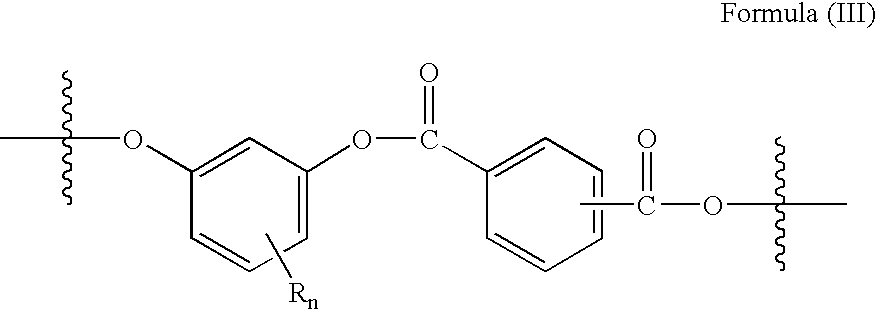Method for preparing copolyestercarbonates
a technology of copolyestercarbonate and composition, which is applied in the field of preparation of transparent, non-ghosting copolyestercarbonate compositions, can solve the problems of affecting the overall transparent appearance of the molded object or film, etc., and achieves the effect of reducing the amount of ghosting and haze, and reducing the amount o
- Summary
- Abstract
- Description
- Claims
- Application Information
AI Technical Summary
Problems solved by technology
Method used
Image
Examples
examples
The following examples are set forth to provide those of ordinary skill in the art with a detailed description of how the methods claimed herein are carried out and evaluated, and are not intended to limit the scope of what the inventors regard as their invention. Unless indicated otherwise, parts are by weight, temperature is in ° C. Molecular weights are reported as weight average (Mw) molecular weight in grams per mole (g / mole) and were determined by gel permeation chromatography (GPC) using polystyrene (PS) molecular weight standards.
examples 1-4
and Comparative Examples 11-15 illustrate the surprising finding that under various reaction conditions, the value of the “% salts” has a pronounced impact on the molecular weight of the product hydroxy-tenninated polyester. Thus, under several sets of conditions where the “% salts” value is in excess of 30%, better control of the molecular weight of the product polyester is achieved.
examples 5-8
To a 1 Liter 5 neck Morton round bottom flask equipped as in Comparative Example 1 was added resorcinol (30.79 g, 30.29 g, 29.79 g, or 29.29 g, 23%, 21%, 19%, or 17% excess based on stoichiometry with diacid chloride), water (31.2 g, 35% salts at the end of oligomerization), methylene chloride (˜200 ml), and triethylamine (0.46 g, 2 mole %). The mixture was stirred with a 3 inch impeller at a rate of 350 rpm. One addition tube was connected to a solution consisting of 0.15 moles (˜30.6 g) isophthaloyl chloride and 0.078 moles (˜15.7 g) of terephthaloyl chloride and 65 ml of methylene chloride. The other addition tube was connected to a 50 wt % aqueous sodium hydroxide solution. Over the course of 15 minutes, the diacid chloride solution and approximately 30.9 g (85% of stoichiometry based on diacid chloride) of the NaOH solution were added at constant molar flow rates to the reactor. Upon completion of the acid chloride addition, a further amount of NaOH solution was added to the r...
PUM
| Property | Measurement | Unit |
|---|---|---|
| molar ratio | aaaaa | aaaaa |
| mole percent excess | aaaaa | aaaaa |
| transparent | aaaaa | aaaaa |
Abstract
Description
Claims
Application Information
 Login to View More
Login to View More - R&D
- Intellectual Property
- Life Sciences
- Materials
- Tech Scout
- Unparalleled Data Quality
- Higher Quality Content
- 60% Fewer Hallucinations
Browse by: Latest US Patents, China's latest patents, Technical Efficacy Thesaurus, Application Domain, Technology Topic, Popular Technical Reports.
© 2025 PatSnap. All rights reserved.Legal|Privacy policy|Modern Slavery Act Transparency Statement|Sitemap|About US| Contact US: help@patsnap.com



